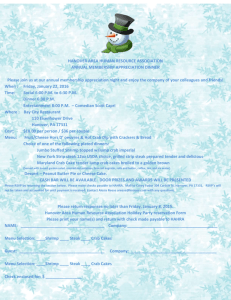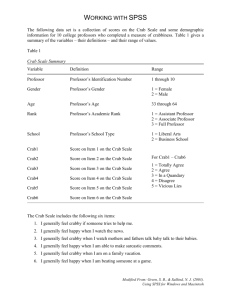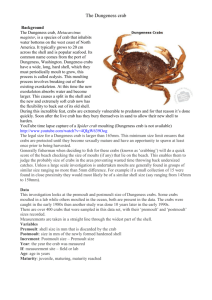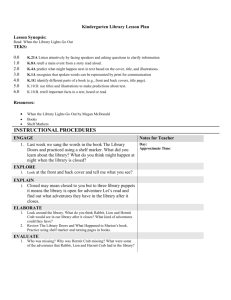A comparison of the effectiveness of bates used in fishing for
advertisement
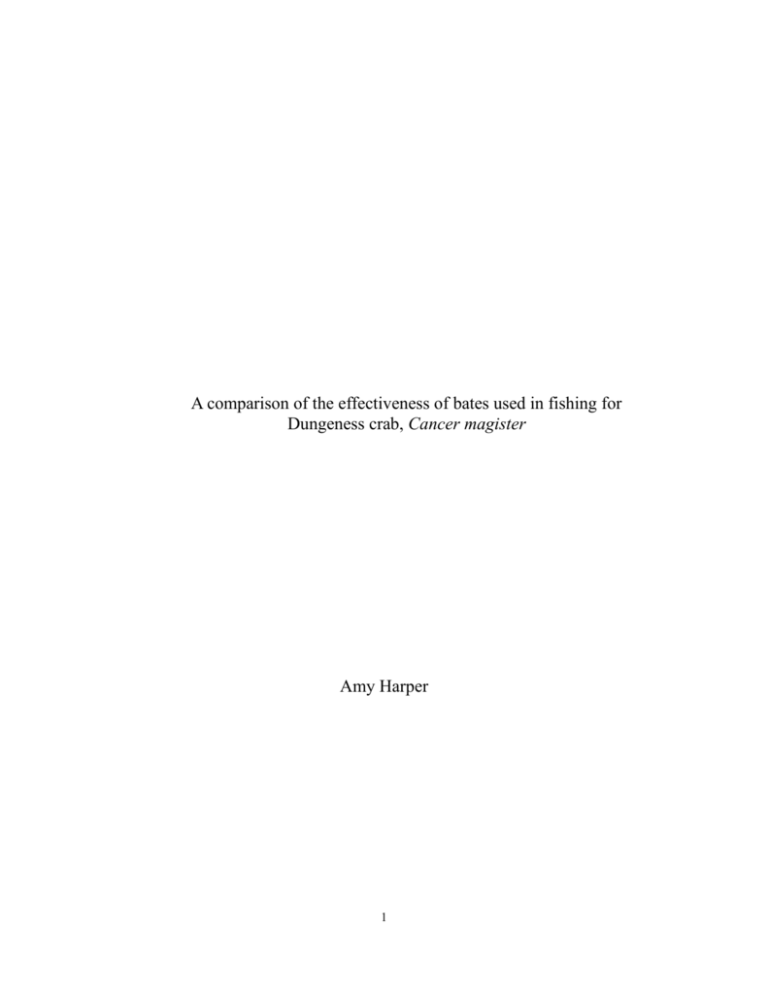
A comparison of the effectiveness of bates used in fishing for Dungeness crab, Cancer magister Amy Harper 1 Table of contents Topic Page Abstract 1 Introduction Background Frequency of prey in stomachs of Dungeness crab Prey of Dungeness crab in Grays Harbor, Washington Reducing variables Determining soak time Variables affecting olfaction Hypothesis 1-3 3 3-4 4 4-5 5 5-6 Methods Preseason Selecting, preparing, and collecting Data Analysis 6 6-8 8-9 Results Shorts Keepers Visual observations Trends over time 9-10 9-10 10-11 11-12 Discussion Analyzing my results Variables Future studies 12-13 13 13-14 Acknowledgments 15 Sources Cited 15-16 2 Abstract Over six weeks five sampling events took place just south of 47.07 N near Grays Harbor, WA. Fish, clams, shrimp, and squid were used as bait in twelve pots, and allowed to soak for four days in the water at a depth of 45-51 meter, and approximately 50 meters apart. After collecting the pots and analyzing the results, the hypothesis that male Cancer magister with a carapace width greater than 165 mm will prefer fish bait was unsupportable. However the trends in data indicate that male Dungeness crab with a carapace width larger than 165 mm prefer clams, where as male Dungeness crab with a carapace width smaller than 165 mm prefer shrimp. Introduction Cancer magister are a species of marine crab commonly known as Dungeness crab. Along the western coast of the United States and Canada, they survive in numbers that support 228 Washington commercial fishermen (Bryant, 2007). Adult male and female crabs live in the intertidal zones, and egg-bearing females migrate to deeper waters to release their eggs in December and January (Ruppert and Barnes, 1995). The larva (zoea) develop for four to twelve months, going through 5 zoeal stages that result in a megalopa (miniature adults). When the zoea takes the form of a megalopa, it settles to the bottom of protective estuaries and shallow intertidal habitats (McEdward, 1995). Juvenile Dungeness crab take one to two years to develop into adults, shedding their hard shells, known as molting, about seven times in their first year and annually after that (Ruppert and Barnes, 1995). Over about four years, the larvae grow into harvestable adult crab, but the adult crab remain vulnerable to predators during periods of molting (Ruppert and Barnes, 1995), Once the old, hard shell has been shed, the newly molted crab is 3 designated as “soft-shell.” Because they lack protection, they often hide in sand or eel grass (Ruppert and Barnes, 1995) and are not allowed to be harvested during this period (WA Administrative Code Sec 220-52-040, 2007). To estimate the age of a crab, scientists measure the carapace width, which is the widest part of the shell in front of the spines. The availability of food and the temperature of water have been shown to influence the rate of growth during all stages of life (Kondzela and Shirley, 1993). Commercial Dungeness crab fishing occurs along the coast, with the major Washington ports in Ilwaco, Chinook, Westport, Tokeland, and La Push. The fishing grounds used by these fishermen/fisherwomen extend from the Columbia River in the south to Cape Flattery near Neah Bay in the north (WA Administrative Code Sec 220-52040, 2007). According to state law, male Dungeness crab with a carapace width of at least 165 mm that are not “soft shell” are legal to harvest, anything smaller or female must be thrown back. There are no regulations about the size or type of boat used to fish for crab. In fact, most are multipurpose boats that can be used for crabbing, salmon fishing, tuna fishing, or deep sea fishing. The equipment also varies, but in this experiment commercial stainless steel mesh pots that are 91-107 cm in diameter and weigh 36-55 kg (R. Harper owner/captain f/v Kathy Anne, personal communication, Sept 2007) were used. Among the Westport fishermen, Bakerview Pots and Harvey Pots are the most popular brands because they have special triggers that allow the Dungeness crab to enter the pot, but not to exit. Other pots have plates that narrow the openings, making it difficult for the crab to escape, but not impossible. Attached to the pot is a long rope with multiple buoys at the end. When the pot is dropped at its desired location, the buoys remain at the surface indicating the location of the pot and who it belongs to. Global 4 positioning systems (GPS) are used to map the fishing ground, making it easier for the fishermen to retrace their steps to find their pots. To be competitive, each boat’s crew uses specific gear to attract the crab; these include different types of bait, pots, lengths of soak time, and secluded fishing grounds that have yet to be discovered by the rest of the fleet. However, Washington state law mandates that every pot be outfitted with a non-biodegradable identification tag, a unique buoy, and a biodegradable cotton escape hatch in case the pot is lost. The cotton begins to decompose once it is in the water, and under prolonged exposure, it will free the crab in approximately three months (R. Harper owner/captain f/v Kathy Anne, personal communication, Sept 2007). My research examined what type of bait attracts the most Dungeness crab. To determine what C. magister consume in the wild I examined previous research on their diet. Gotshall (1977) collected 208 crabs from two locations on the northern Californian coast; Humbolt Bay and ocean waters west of Eureka, with depths ranging from zero to 89 meters deep. Clams had the largest overall frequency of occurrence, with fish more frequent at shallow depths (0 - 17.9 meters), and polycheates, isopods, echinoderms, and clams were more frequent at depths of 53.9 meters and greater (Gotshall, 1977). In summary, C. magister eat different animals at different depths. While Gotshall recorded the carapace width and sex of each crab, he did not analyze data by size or sex. Instead, he grouped them into five groups by depth of capture in intervals of 18 meters (Gotshall, 1977). Stevens et al. (1982) collected 410 crabs and examined their stomach contents from four locations within Grays Harbor, an estuary on the Washington coast. They 5 divided the crabs into three categories based on carapace width but did not distinguish between sexes. Overall, the most abundant prey for the Dungeness crab was sand shrimp (Crangon septemspinosa). However, they concluded that the three categories of crab had different preferences of prey: smaller crab (15 - 60 mm carapace width) ate very small bivalves or small crustaceans; medium crab (61 - 100 mm carapace width) consumed fish and sand shrimp; and the largest crab (101 - 160 mm carapace width) still ate the shrimp but had larger amounts of fish in their stomachs (Stevens et al., 1982). This study influenced my selection of bait, because it collected C. magister from Grays Harbor and described what each carapace width category preferred. To reduce field variables as much as possible, I employed techniques used by Taggart et al. (2004) in their study of crab pots and dive transects to estimate C. magister density. They were located in Glacier Bay, Alaska and wanted to determine if collecting crab with commercial pots or using divers to go down and count them yielded better samples. Locating areas to set my pots depended on the locations that were available, but the depth and preparation of my pots were similar to each other throughout the experiment to eliminate or reduce unwanted variables. Taggart et al. (2004) stressed the importance of this in estimating abundances that would be used to set quotas, track population, and measure growth rates. By using the same size and design of pots, keeping fresh bait available, and using consistent short soak times and a uniform depth, they ensured that their counts would accurately represent the Dungeness crab population (Taggart et al., 2004). Another experiment that helped me set the parameters of my experiment was published in 1974 by Bennett. This study looked at the effect of pot immersion time on 6 the amount of crab caught. Located in Devon, England, an environment similar to that in Washington, he collected data from a fisherman’s log book to determine the correlation between soak time and the mass of crab caught. Bennett (1974) determined that the length of pot immersion has a positive effect on the amount of crab caught. A soak of four days resulted in more crab when compared to ones that soaked for longer and shorter times. A longer soak can result in dead crab which cannot be sold; this explains the lower mass of crab for extended soaks. Shorter soaks do not give crab enough time to locate the pots. It worked best to soak my pots for four days because of Bennett’s conclusion and my time constraints. Ultimately knowing how Dungeness crab are attracted to their prey will give me an advantage when testing my baits. Adult crab rely on olfaction to guide them to mates and prey (Ruppert and Barnes, 1995), and the research preformed by Finelli et al. (2000) looked at the variables that affect olfaction in blue crabs. Using experimental plumes mixed with fluorescein-dyed seawater, they tested the rate of odor release (concentration), odor composition, and rate of flow. Finelli et al. (2000) determined that the concentration and rate of flow had a greater effect on search success (finding the source of odor), than chemical composition, because certain plumes attracted the crab at higher concentrations and/or flow rates. However, when the concentrations and flow rates were lowered, the crab did not show the same response. This indicates that crab search for food using olfaction. Finelli et al. (2000) concluded that concentration of odor determines crab travel, larger concentration increases the accuracy with which the crab find the source. After researching what C. magister prey on in the wild, my hypothesis was that 7 the pots baited with fish will attract more legal size (carapace width of 165mm or more) male Dungeness crab than those baited with clams, shrimp, or squid. Based on Gotshall (1977) and Stevens et al. (1982) previous research, with fish being the predominate organism identified in C. magister stomachs, I selected fish as my preferred bait because I experimented in shallow water and just north of Grays Harbor, combining results from Gotshall (1977) and Stevens et al. (1982). With soaks of four days, large males will be able to find the pot, and smaller males and females will have time to escape from the pot or be crowded out by the larger males. Methods Preseason Before the season opened on December 1, 2007, I traveled to Westport, WA to prepare each 1 meter steel crab pot with rope, buoys, and bait boxes; and order/collect my bait. Three of the four types of bait tested (a mixture of frozen Clupea harengus, Tiger Mackeral, and Hake; a mixture of frozen squid and frozen Siliqua patula) were ordered from Washington Crab Distributors, the same cannery to which we deliver our catch. To ensure its freshness, the bait was delivered two days before each trip. The fresh Crangon spp. were harvested on the beaches surrounding Westport by myself and some volunteers. In each steel crab pot, a bait box and bait net hang in the center, together holding 0.91 kilograms of bait. Buoys, rope, pots, and hydraulics were checked for wear, and minor repairs made before the start of the season. Selecting, Preparing, and Collecting The fishing grounds that were used are located north of Westport, just south of the 47°.07.00” N latitude line. As the boat made its way to the fishing grounds, I prepared the 8 bait by filling 3 bait boxes with fish bait, 3 with shrimp bait, 3 with clam bait, and 3 with squid bait. I did not use a control, or pots without bait, because I was not testing the effectiveness of bait, rather preference in the four I had selected. The fresh fish used in this experiment was a mixture of Tiger Mackerel, Herring, and Hake. Stevens et al. (1982) determined that sand shrimp (Crangon spp.) are favored by crab near Grays Harbor, so I used chopped and whole sand shrimp. Since razor clams (Siliqua patula) and a mixture of squid are the bait of choice among Westport fishermen (R. Harper owner/captain f/v Kathy Anne, personal communication, Sept 2007), and because Stevens et al. (1982) and Gotshall (1977) found clams in the stomachs of Dungeness crab in their experiments I decided to include clams and squid in my experiment. Placement of the pots was the most important variable that I had to deal with, making sure that the pots were placed far enough apart to differentiate between the baits, yet not so far that the crab could not choose between the two. The pots were set in order of the bait that they held: fish, shrimp, clam, and squid. This pattern was repeated until all the pots were set in the shape of a horseshoe when viewed from above. This shape provided enough separation but kept them close enough to give the crab some choices. Radar was used to determine the depth of the water; the average depth was 25-28 fathoms (approximately 45-51 meters). The twelve pots in each trial were placed approximately 50 meters apart, a distance chosen based on recommendations and field experience. This distance provided enough time to unload the pots, sort crab, rebait and then reset the pots without having to stop the boat or backtrack (R. Harper owner/captain f/v Kathy Anne, personal communication, Oct 2007). In all, five trials with twelve pots per trial gave me twelve pots per bait and 60 pots total in my study. 9 Bennett (1974) examined a correlation between the length of time a pot spent in the water (soak time) and the amount of crab collected. With his recommendations I soaked my pots 3-4 days, weather permitting. This length allowed for the crab to find the pots, but prevented overcrowding in the pot by leaving it in the water longer. Overcrowding can lead to death of crab and thus not attract other crab to the pot (R. Harper, personal communication, Oct 2007). Upon harvesting the pot and sorting the crab, I recorded the total number of crab, number of males, and number of legal size males. The boat continued to collect crab until all of my pots were collected, and then returned to Westport to unload at the cannery or finished fishing the rest of the gear. Each trip lasted the entire day, leaving Westport, WA at five o’clock in the morning and returning after eight o’clock in the evening. Data Analysis I categorized my data into four groups that correspond with the types of bait I used. Under each bait category I sorted them by sex and carapace width of males, shorts and keepers. Shorts are males with a carapace width of < 165 mm and keepers are males with a carapace width of > 165mm. Selecting my specific target of males with a carapace width of 165 mm or more (legally harvestable/ keepers), I was able to determine their preference. While males are more aggressive during the season pushing out the females, if a female was caught in a pot her presence could increase the number of males who want to mate with her. Using a one-way ANOVA test, I compared the numbers of legal males for each bait rather than each trial. My alternative hypothesis was that male Dungeness crab with a carapace width of 165 mm or more would prefer fish, and thus my null hypothesis was 10 that male Dungeness crab with a carapace width of 165 mm or more would not prefer fish and there would be no difference between the baits. My level of significance is 0.05 or a confidence level of 95%. In Minitab® a one-way ANOVA test and a Tukey test, if needed, can calculate the standard sampling distribution, and calculate the test statistic and its standardized value, resulting in a p-value. If my p-value is less that my level of significance I will reject my null hypothesis. However, if my p-value is not less than my level of significance I will have to fail to reject my null hypothesis. Results Of the 60 pots that were set and collected, only 6.5% had less than two male crab total, 6.5% had no male crab over 165 mm, 5% had no male crab when collected, and no female crab were collected in this study. The pots with the largest numbers of crab in a single pot had clam and squid bait, each pulling in nine crabs in a single pot, while fish bait had the most pots collecting two or fewer crab. After running a one-way ANOVA test there was no statistical significant difference between the four baits in both the shorts, males with a carapace width < 165 Fish Squid Shrimp Clam Type of bait Figure 1. The number of Dungeness crab smaller than 165 mm (shorts) collected five times off the coast of Washington, south of 47° 07’ N. The average was based on 12 pots per treatment. Error bars represent the calculated standard deviation. 11 Fish Squid Shrimp Clam Type of bait Figure 2. The number of Dungeness crab larger than 165 mm (keepers) collected five times off the coast of Washington, south of 47° 07’ N. The average was based on 12 pots per treatment. Error bars represent the calculated standard deviation. mm, (Figure 1) (F=1.15, df=3, p=0.342) and keepers, males with a carapace width > 165 mm, (Figure 2) (F=1.67, df=3, p=0.189) crab categories. To further compare if bait has an influence on the size of the crab caught, I ran one-way ANOVA tests between the sizes of crab in each bait. Squid, fish, and shrimp showed no statistical significant difference between the numbers of shorts to the number of keepers (F=1.64, df=7, p=0.136). However the data collected with clam bait signifies a statistical significance between the greater number of shorts when compared with the lesser number of keepers (F=5.6, df=1, p=0.028). The trends in average number of crab per pot with a carapace width > 165 mm indicate a preference for clam bait over squid, shrimp, and fish. Trends are also observed when the averages of crab per pot with a carapace width < 165 mm are compared. These smaller crabs tend to prefer shrimp bait over squid, clams, and fish. Visual observations were also collected (Table 1), including bait prepping, bait location in pot, and bait appearance upon collection. The shrimp were harvested by hand, which can lead to mashing/crushing of the shrimp. These shrimp were loaded into the 12 bait boxes and nets as collected, fresh and without further chopping. Fish and clams were purchased frozen and whole, then loaded into bait boxes and nets without chopping. Squid were also purchased in frozen blocks and whole, then chopped to fit into the boxes and nets. While all the baits are inexpensive, the cannery where we purchased our baits does not sell sand shrimp. The amount of time and money to harvest the shrimp and/or unpopularity in Westport could account for their absence. Table 1.The visual observations of bait collected over five sampling events north of Grays Harbor, WA. All baits were placed in bait nets and boxes. Price is also included. Bait Fish Squid Shrimp Clam Fresh/Frozen Frozen Frozen Fresh Frozen Preparation Method Whole Chopped Chopped & Whole Whole Bait Appearance Tough Slimy Tough Slimy Cost per pound $0.35 $0.65 ---$1.95 The bait boxes and nets were not placed in the same location in the pot. The nets were positioned closer to the entrance while the boxes were suspended in the center. This gave the crab easy access to the nets, allowing them to remove more bait from them. Clams and squid placed in the nets were cleaned out by the crab, as observed when the pots were collected, while fish and shrimp were left over. Texture of the clams and squid also changed to a softer slimy tissue, unlike the fish and shrimp which maintained their tough shells and scales. Over the course of the experiment, the total number of crab declined after two months of harvesting (Figure 3). These data are consistent with the rest of the pots harvested outside the experiment. All crab collected were healthy and had completed the molting cycle. Other organisms that were collected were sand dollars, hermit crabs, sea stars, and eel grass. Weather did not affect the soak time. 13 12/20/07 1/17/08 2/3/08 Sampling Dates 2/17/08 3/3/08 Figure 3. The average number of male Dungeness crab collected per pot for each sampling event. Location of collection is off the coast of Washington, south of 47° 07’ N. Each date signifies a sampling event. The error bars represent the calculated standard deviation for each date. Discussion After running statistical analysis of my results, I am unable to support the hypothesis stated previously with the data that I collected between December 20, 2007 and March 2, 2008 from the coast of Washington south of 47º 07’ N. I expected to find that fish bait would attract more crab per pot, and thus more crab overall when compared to squid, shrimp, and clam bait (Stevens et al., 1982. Gotshall, 1977). Additionally, I also expected to collect mostly males with a carapace width of more than 165 mm and no females of any size (R. Harper owner/captain f/v Kathy Anne, personal communication, Sept 2007). The results have shown that there are no statistically significant differences between the four baits when the crab were separated by carapace width (F=1.15, df=3, p=0.342; F=1.67, df=3, p=0.189). We did however collect more males with a carapace width of more than 165 mm and no female crabs were caught. The trends represented in Figure 2 are that more keeper (greater than 165 mm carapace width) male Dungeness 14 crabs were collected per pot on average when baited with razor clams. This may be due to their preference for the razor clam bait because it is native to the area and part of their diet (Stevens et al, 1984. Gotshall, 1977). By not having statistically significant differences and accepting my null hypothesis, my results do not influence the bait choices of Westport, WA Dungeness crab fishermen. Upon further testing, they may accept some new suggestions, but without scientific evidence, change is unlikely to occur. Some variables that could have contributed to collecting data that did not agree with my initial expectations are pot placement, overall low crab population, and crab not having a preference in bait. One of my primary concerns was placing the pots at the same depth and in close enough proximity to one another without crowding them together. Using a radar depth finder I was able to select places that matched my depth requirements, but this compromised the exact distance between each pot and the overall shape of the string. Each pot was thus not given an equal opportunity to be chosen by the crab. Another factor was the low amounts of crab that were being harvested and delivered to Westport, WA (R. Harper owner/captain f/v Kathy Anne, personal communication, Sept 2007). These low numbers decreased my sample size and ability to statistically distinguish a difference between the four baits. Finally, there is a small chance that Dungeness crab (Cancer magister) may not have a preference in bait to begin with. While they may feed on shrimp, fish, and other crab in the wild (Stevens et al., 1982. Gotshall, 1977), when presented with bait, they may see it as an opportunity for a free meal and are not discerning about what is in the pot. To preclude these sources of error, more tests should be done to further explain my results. Rather than place pots in a string with the baits separated from one another, 15 they could be placed in clusters of four; each pot representing the different bait, that way crab would be attracted to the pots then make the choice to enter certain bait’s pot. Therefore depth would not have to be taken into account because all four baits would be in the same environment, attracting the same crab. Repeating the experiment annually could show trends in bait preference and crab sample size over the same time period with the same number of sampling events. Knowing whether the decline in crab was due to a bad season or poor placement of pots would allow me to change the number of sampling events and/or change the location of the pots after each sampling event. To ultimately control every aspect of the experiment, lab tests could also be done to know exactly what bait crab prefer. Setting up tests in tanks with Dungeness crab and bait boxes with their respective baits could ultimately show their feeding habits. Seeing my results and knowing what steps should be taken to clear up some loose ends, more questions have come up after completing my experiment. Gotshall (1977) and Stevens et al.(1982) have explained what Dungeness crab feed on in their natural environment, but what would be their preference if given other baits, such as chicken, beef, or synthetic jelly baits? Both experiments found that a large portion of Dungeness crabs’ diet is other crab. Using live juvenile Dungeness crab as bait to harvest large male crab could also be included in future experiments but probably not expanded to commercial harvesting because of possible crab population decline. A study done by Fernandez (1999) looked at the trends in crab that cannibalize on smaller crab. They analyzed by size and habitat, concluding that smaller crab (carapace width of < 110 mm) and ones that live in the mud have a higher density of cannibalism. This experiment could be expanded to larger crab (carapace width > 150 mm). I would like to attempt this 16 experiment with the new ideas stated above and a fresh perspective about how to conduct it. Acknowledgments I would like to thank Ronald Harper, owner and captain of f/v Kathy Anne, Charlie Wilson and Ero McNett, deck hands on f/v Kathy Anne, and Larry Christensen, owner and captain of f/v Kristina, for allowing me to tag along with them for four months, answering all my questions, and not making fun of me when I was sick. I also appreciated the time dedicated by Dr. Olney, Dr. Coby, Dr. Hartman, and my classmates in senior seminar for giving me advice and reading my papers. Sources Cited Bennett, D.B. 1974. The effects of pot immersion time on catches of crabs, Cancer pagurus L. and lobsters, Homarus gammarus (L.). Journal du conseil. 35(3):332336. Bryant, B. Coastal Commercial Dungeness Crab Fishery [Internet]. Montesano (WA): Washington Department of Fish and Wildlife; 2007 [cited 2007 Sept 27]. 3 p. Available from http://wdfw.wa.gov/fish/shelfish/crabreg/comcrab/coast/index.htm Fernandez, M. 1999. Cannibalism in Dungeness crab Cancer magister: effects of predator-prey size ratio, density, and habitat type. Marine Ecology Progress Series. 182:221-230 Finelli, C.M., Pentcheff, N.D., Zimmer, R.K., Wethey, D.S. 2000. Physical Constraints on Ecological Processes: a Field Test of Odor-Mediated Foraging. Ecology. 81(3):784-797. Gotshall, D.W. 1977. Stomach Contents of Northern California Dungeness Crabs, Cancer magister. California Fish and Game. 63(1):43-51. Kondzela, C.M., Shirley, T.C. 1993. Survival, feeding, and growth of juvenile Dungeness crabs from southeastern Alaska reared at different temperatures. Journal of Crustacean Biology. 13(1):25-35 McEdward, L. 1995. Ecology of Marine Invertebrate Larvae. CRC Press LLC,FL, pp.79118, 249-272. Ruppert, E.E., Barnes, R.D. 1994. Invertebrate Zoology, 6th ed. Harcourt Brace College Publishers, pp. 678-799. Stevens, B.G. , Armstrong, D.A., Cusimano, R. 1982. Feeding habits of the Dungeness crab Cancer magister as determined by the index of relative importance. Marine Biology. 72:135-145. Taggart, J.S., O’Clair, C.E., Shirley, T.C., Mondragon, J. 2004. Estimating Dungeness 17 crab (Cancer magister) abundance: crab pots and dive transects compared. Fishery Bulletin. 102:488-497. Washington Administration Code, Title 220, Chapter 220-52, Section 040,043,046. Text from Washington State Legislature. Effective 12/21/2007. Available from http://wdfw.wa.gov/fish/shelfish/crabreg/comcrab/coast/index.htm Washington Administration Code, Title 220, Chapter 220-20, Section 025. Text from Washington State Legislature. Effective 12/21/2007.Available from http://wdfw.wa.gov/fish/shelfish/crabreg/comcrab/coast/index.htm 18
